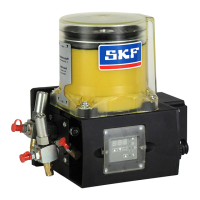6. Operation
6.1. General information
The piston pump unit described functions
automatically. You should, however, still observe the
following instructions to provide for trouble-free
operation:
o Perform a functional check on a regular basis by
initiating an interim lubrication.
o Inspect the lubrication of the lubrication points
on a regular basis.
o Perform a visual check of the lubricant fill level in
the lubricant reservoir at regular intervals
(including on piston pump units with fill level
monitoring).
If the lubricant fill level is too low, top up to the
maximum mark as described in Chapter 6.2,
"Filling the lubricant reservoir".
Warning!
The lubricant reservoir must not be
completely emptied, as this may result in
damage or destruction of the machine
components requiring lubrication.
If the lubricant reservoir has been emptied
to the point that lubricant no longer flows
from the outlets, the entire centralized
lubrication system must be refilled and
then vented ( Chapter 6.3, "Vent
centralized lubrication system").
6.2. Filling the lubricant reservoir
Observe the instructions from the machine
manufacturer regarding the lubricants that
are to be used.
Warning!
Only fill using clean lubricant and an
appropriate device. Contaminated
lubricants can result in severe system
malfunction. The lubricant reservoir must
be filled without introducing bubbles.
Warning!
Different lubricants must not be mixed
together. Doing so can cause damage and
require extensive cleaning of the piston
pump unit/centralized lubrication system.
It is recommended that an indication of the
lubricant in use be attached to the
lubricant reservoir in order to prevent
accidental mixing of lubricants.
The lubricant may only be fed without bubbles. The
lubricant reservoir, if present, must be filled with
clean lubricant without introducing bubbles.
Lubricant is filled using a DIN 71412-AM10x1
conical head nipple and a conventional grease press.
When the unit is filled for the first time, the lubricant
forces the follower piston upward until the overfill
outlet opens. As filling continues, the air escapes
until the entire lubricant reservoir is filled with
lubricant. Stop filling immediately when excess
lubricant starts to emerge from the overfill outlet.

